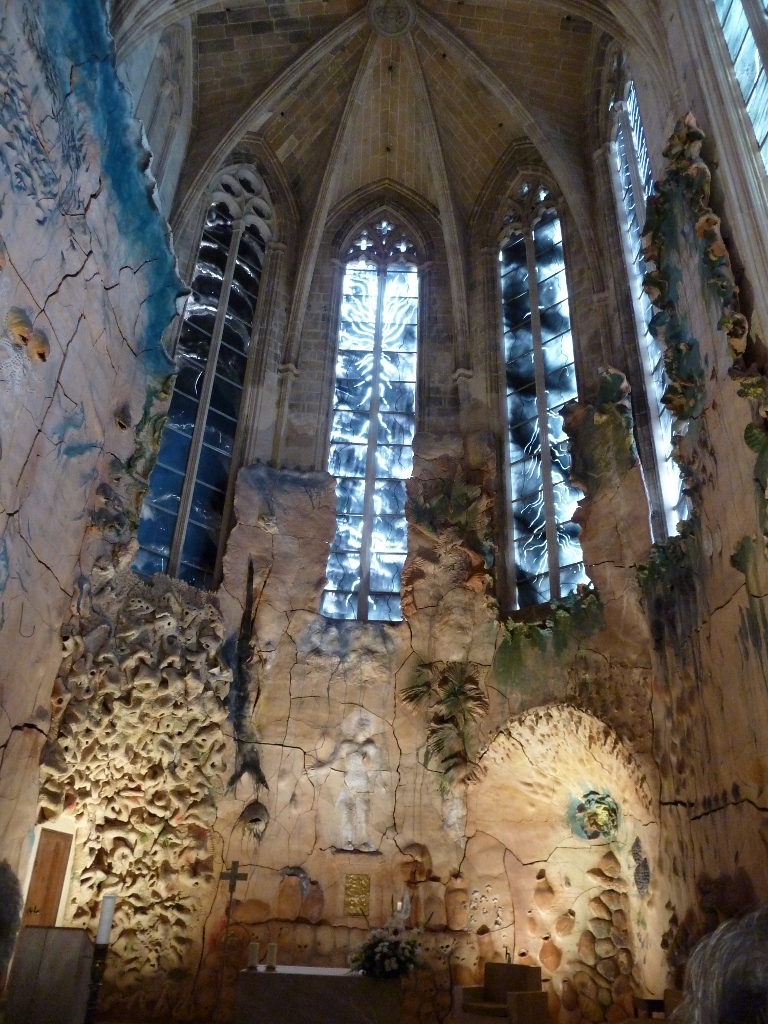 |
| San Roque Arch in Mahon |
20thMay Finally,
the winds have eased so today we set out for Minorca. We had originally planned
to anchor on the south coast, but as the winds were good we kept going and headed for
the island’s capital, Mahon instead. After a 10 hour sail we crept into
the anchorage just outside the town and found that our friends Bev and David on
Tumbalong, whom we first met in Plymouth, were already anchored here. They
rowed across and we caught up with our news over a bottle of wine.
21stMayThis morning
another familiar boat sailed into the anchorage: Charlie and Alison on Sulaire,
who over-wintered with us in Cartagena. The winds were getting up again so we
decided to take the dinghy for the half mile ride over to the nearest shops
before the waves built too much. On the way out of the anchorage we picked up orders
for milk and bread from Sulaire and Tumbalong. The journey over wasn’t too bad,
but by the time we’d stocked up and returned to the dinghy there was quite a
chop running and each time we hit a wave, spray arched over the front of the
dinghy. I got quite wet, but we somehow managed to keep the six baguettes dry!
.jpg) |
| Sulaire in the anchorage at Mahon |
When I came on deck this
afternoon after lunch, I saw a green buoy I hadn’t notice before next the boat.
It took me a full minute to realise it was the channel buoy and our anchor was
dragging! As we pulled the anchor up we noticed that another boat had dragged too.
We eventually found a more sheltered spot to anchor in and dropped more chain. The
forecast for tonight is a force 8 gale.
By midnight
the wind is was screaming through the rigging and boat is pulsating. Cliff goes to
bed but I can't sleep, so I stay up reading and regularly check that the anchor
hasn’t dragged. By 2am I am exhausted and fall asleep. At 3am Cliff gets up and
checks the anchor. At 4am I check the anchor again and then set the anchor
alarm on the GPS before finally falling into a deep sleep. At 5.30am we are
woken by someone sounding a manual fog horn. Cliff goes up on deck and shouts
‘We’re dragging’ before turning the engine on full revs. We have dragged 60ft
and are about to hit another boat!
As I
emerge on deck our GPS anchor alarm finally goes off. Cliff tells me to pull
the anchor up, so I go forward and start raising it, but then the windlass
jams. We change places and as I take the helm we realise the chain is caught
under the boat, and the only way to free it is to reverse back towards the
other boat. It’s a close thing, but we finally manage to free the chain without
hitting the boat. We turn and I manoeuvre us back into the screaming wind to
find somewhere to drop the anchor again. The anchor bites and Cliff drops even
more chain. For the next hour or we sit on deck staring at the landscape,
willing the anchor to stay in place. Finally, the wind begins to ease a bit and
we begin to relax.
.jpg) |
| Marina in Mahon |
As
soon as the wind has died down we head out of the anchorage and into the marina
in town. Our new berth is in an inlet sheltered from the wind. All is quiet and
the boat is still. We both fall asleep.
We
later discover that it was our friend Bev, on Tumbalong, who had seen us
dragging and sounded the alarm. Thank goodness – a few more minutes and the
damage could have been substantial.
.jpg) |
| Some of Mahon's lovely architecture. Note the sash windows |
.jpg) |
| Colonial style housing in Mahon |
26th
May We have had a relaxing week in Mahon, exploring the town and catching up
with boat jobs. It’s a lovely town, quiet, not too touristy and full of
interesting buildings. The town is set in a deep harbour and this, plus its
location in the middle of the Mediterranean, made it a prime target for invaders.
The British occupied the town in the 18th century and you can still
see their legacy – many of the houses have sash windows and there are several
grand buildings built in colonial style.
The
winds have continued all week, and are due to blow hard next week too. But
there will be a couple of days’ grace between one weather front and the next, so we are
thinking about using it to cross to Sardinia, as we need to be in Alghero by
June 4 to meet my friend Liz, who will
be sailing with us for a couple of weeks.
.jpg)

.jpg)
.jpg)
.jpg)
.jpg)
.jpg)
.jpg)
.jpg)
.jpg)

.jpg)
.jpg)
.jpg)
.jpg)
.jpg)
.jpg)
.jpg)


.jpg)
.jpg)
.jpg)
.jpg)

.jpg)
.jpg)
.jpg)
.jpg)
.jpg)

.jpg)
.jpg)
.jpg)
.jpg)
.jpg)
.jpg)